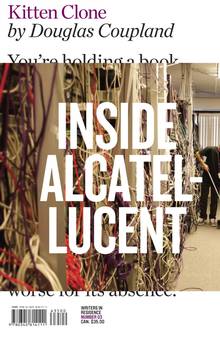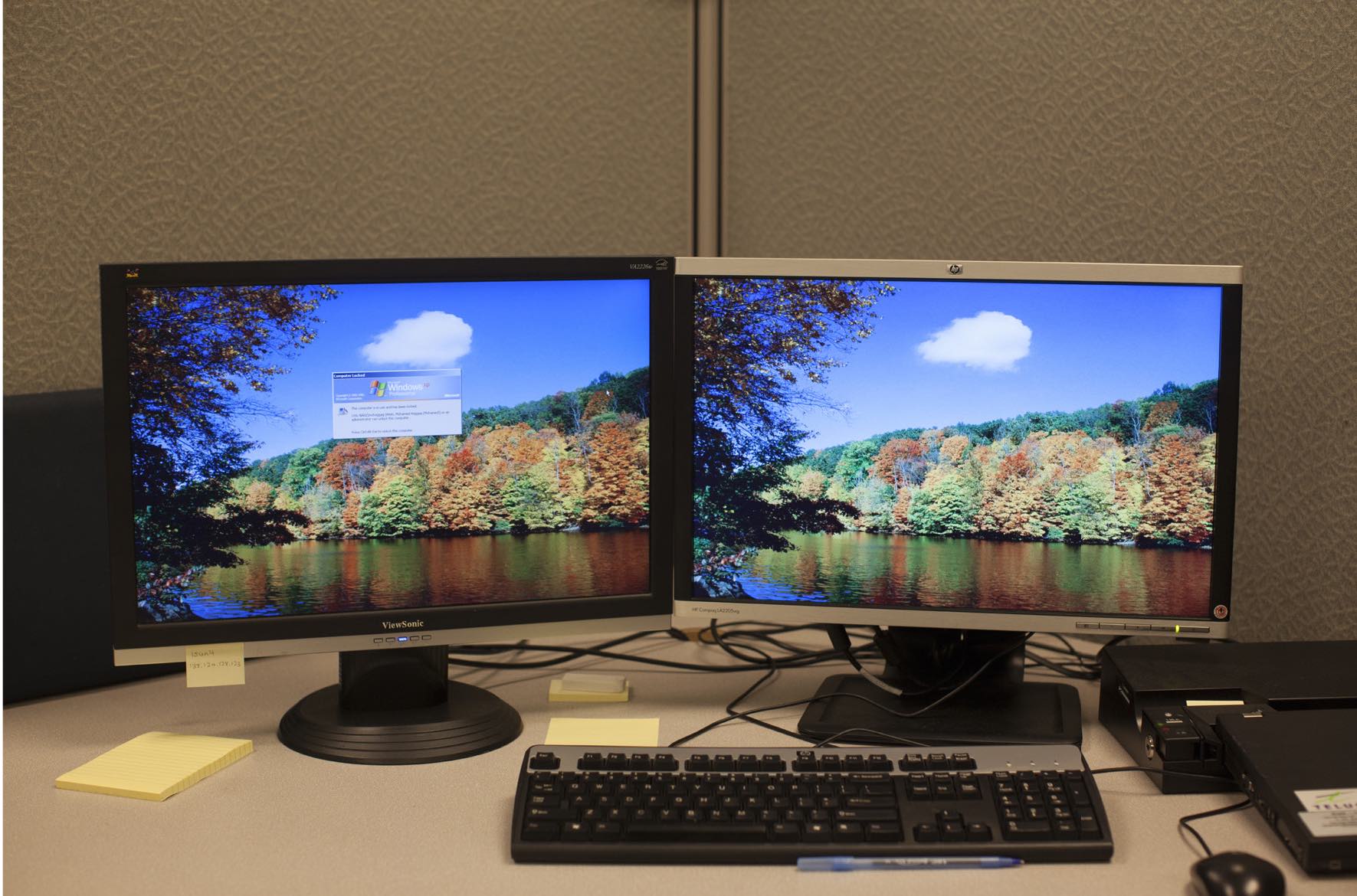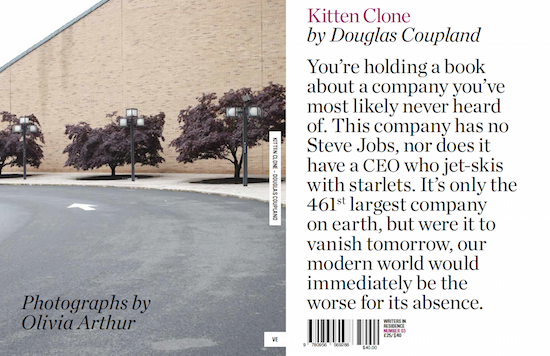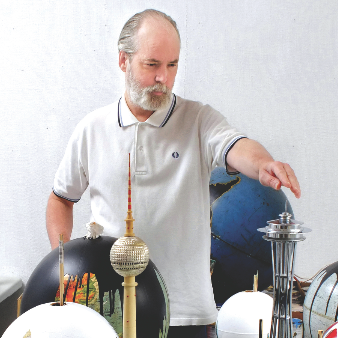Book Excerpt by Douglas Coupland
From Kitten Clone: Inside Alcatel-Lucent
Editor’s Note: Douglas Coupland’s book about “a company you’ve most likely never heard of” leaps between text and photos (by Olivia Arthur), reportage and classic Coupland riffs (“My lungs feel like bags of romaine lettuce forgotten in the fridge’s crisper”). More than anything, it’s a brilliant and scary meditation about the Internet's impact on our minds and selves. As Coupland puts it, “I miss my pre-Internet brain.”
 Kitten Clone, published by Visual Editions in 2014, is part of Alain de Botton’s Writers in Residence series. Since de Botton wandered around Heathrow Airport in 2009, producing A Week at the Airport (Vintage, 2010), he’s asked other authors like Coupland to write their own inside stories of large corporations. A recent Irish Times article quotes de Botton as saying:
Kitten Clone, published by Visual Editions in 2014, is part of Alain de Botton’s Writers in Residence series. Since de Botton wandered around Heathrow Airport in 2009, producing A Week at the Airport (Vintage, 2010), he’s asked other authors like Coupland to write their own inside stories of large corporations. A recent Irish Times article quotes de Botton as saying:
Businesses and organizations are the new Africa. They are dangerous, forbidden and very, very interesting.
Coupland takes on Alcatel-Lucent, a French-based global conglomerate. He organizes the book into three main sections—“Past,” “Present,” and “Future”—based on his visits to “Alca-Loo” locations in France, Canada, China, and the U.S. The excerpt that follows comes early on (from the "Past") and involves Bell Laboratories in New Jersey, where the Internet got its start in 1969.
With the permission of Visual Editions and the author, we’re delighted to reprint this selection from Kitten Clone as part of the TW Reading Series.
But, you ask, what’s a kitten clone? Coupland’s extended thought experiment includes a character named Alphonse Garreau, who in 1871 envisioned spreading the image of a kitten around the world. We can’t give away what happens at the end of the book, but that cute little kitty keeps shifting realities, a blend of fact and fiction that’s as strange as the Internet itself.
For more information about the book and the Writers in Residence series, go to the Visual Editions page for Kitten Clone: Inside Alcatel-Lucent.

The shuttle bus from the local hotel drops me off outside what appears to be an architecturally unmodified early-1980s facility for making robot housewives. Hot robot housewives. Hot corn-fed robot housewives who look like Ann-Margret in her prime. Housewives who spend their off-hours in sunless living rooms, their internal servers humming on PAUSE, blindly flipping back and forth through pages of old Life magazines that smell like a basement, their software awaiting the 6:30 a.m. release signal, when they will proceed upstairs to administer wake-up backrubs to their masters.
But I’m actually standing in front of Bell Laboratories—Bell Labs—a sprawling industrial research campus built of brick the color of a wet golden Labrador, in the center of suburban New Jersey’s belt of once-utopian corporate campuses that began springing up here in the 1950s, the acme of the military industrial complex era. A pyramid- capped core building, maybe eight stories high, has two symmetrical wings that flank the central area and absorb what is clearly an older, 1940s utilitarian structure, visible at the complex’s rear side, to the east. The oak trees here are big; maybe they were planted back then.
It’s late February, and the grass surrounding the complex is brown. The bus driver, who spends eight hours a day pinballing between corporate campuses, including L’Oréal, Sandoz, Ciba-Geigy, and NCR (there’s not enough population in the region to support a full-time local taxi), tells me there’s been no snow this year. He tells me he hopes the absence of snow isn’t thanks to human beings. “It’s getting harder and harder not to believe in global warming, but I’m still going to keep on trying. I hope that whatever you’re doing in that building isn’t wrecking the snow.” As he closes the door, he shouts, “You be good!”
The outside air is just above freezing, and it’s humid. My lungs feel like bags of romaine lettuce forgotten in the fridge’s crisper. Out by the main road there’s a field of solar panels, but it’s hard to imagine anything extracting energy out of a day like today.
I’m discombobulated this morning because I forgot my iPhone, so I have that homesick, disconnected feeling you get when you realize you’re phoneless. I’m jet-lagged, and I’m concerned because the date on the shuttle bus’s dashboard clock reminded me that it’s already February. Time is moving too quickly these days—and yet, at the same time, it’s moving too slowly. And it’s not just that I’m growing older. Quite simply, my brain no longer feels the way it used to; my sense of time is distinctly different from what it once was, and I miss my pre-Internet brain. The Internet has burrowed inside my head and laid eggs, and it feels like they’re all hatching. Welcome to the early twenty-first century, a world where the future somehow feels like...homework.
Of course, I know that my perception of time’s passage is not changing because of Internet eggs hatching inside my brain. What’s really happening is that, after more than ten thousand hours of exposure to the Internet and digital technologies like my iPhone, my brain has been rewired—or, rather, it has rewired itself. Science has a name for this process: Hebb’s Law. When neurons fire together, they wire together. It’s no coincidence that the ten-thousand-hour rule has recently entered our culture’s popular imagination, explaining to us that after doing something for ten thousand hours, you become an expert at it, because that’s how much time your brain needs to fully rewire itself to adapt to a new medium.
Ask yourself if you’ve spent ten thousand hours on the Internet, then think about your own brain. It’s clear there’s a new neural reality. If you’re in doubt, look at people younger than you. Do they interact with other people and the world differently than you did when you were their age? Of course they do. So, sometime between then and now, big changes have occurred. Our attention spans are collapsing: We want movies; we want music; we want unfiltered information. We want Season Four of Dexter. And we want it all now. Nearly omniscient levels of information are now cheaply available across pretty much all cultures and to most of the world’s citizens. As a result, politics is changing. Religion is changing. Our sense of intuition is changing. The way we solve problems is changing. Everything is changing, and far too quickly to be absorbed, especially by people who lived in the 1970s, when the single biggest tech improvement over a decade was the addition of an FM dial to car radios, or people who lived in the 1980s when the single biggest tech upgrade was the ability to create a mixed-tape cassette for your girlfriend. Acceleration is accelerating.
I think of this while watching Bell Labs workers bustle into the building. They’re mainly flowing up from the lower parking lot where they parked a fleet of silver, white, and black sedans. Many are carrying briefcases and messenger bags containing laptops: These days, you bring your own computer to work.
I enter through gold-tinted glass doors on the west side of the building, and the early-1980s fantasia continues. The high-ceilinged concrete space is filled with display cases filled with artifacts filled with astonishing significance: the world’s first transistor (1947); the world’s first laser (1957); a replica of the world’s first satellite (1961). A plasma TV displays in real time the current number of patents generated by the building’s occupants: 29,002 as of this morning.
This place feels like the world’s biggest dad’s den. No, that’s not quite right. It’s more like...it’s more like if you were shopping for vintage motherboards on Craigslist and you drove to an E.T.-style suburb and knocked on the garage door, where there’s a rental suite, and a guy opens the door—his name is Gavin—and inside, Gavin is surrounded by his tech shrines: dust-free gaming consoles, a kendo sword in a special Japanese-made sword-holding rack, several autographed baseballs, and maybe a few sci-fi figurines, and while his stuff is arguably quite cool, it’s also very hard not to notice that Gavin doesn’t have a girlfriend. Does that make sense?
So, here I am in the lobby of a building filled with some of the coolest stuff in human history, in a massive Gavin-style space, and I’m trying to figure out how to hook the building up with a date—perhaps with the L’Oréal campus a few miles to the south.
I head to the desk to obtain my security badge. It’s very dark in here: No bulb seems to have a higher wattage than 40, and half of them are switched off. While pinning on my badge, I look up. There, attached to a concrete rotunda above me, is a foam-core board bearing a lavender circle the size of a basketball hoop—it’s the first springtime color I’ve seen since entering the building. And inside the circle is...a protein molecule? A Japanese hiragana character? No, it’s a corporate logo, an abstraction of our two friends, the letter “A” and the letter “L.”
The “A” stands for Alcatel, and the “L” stands for Lucent.
Alcatel-Lucent owns Bell Labs.
Most of us have never heard of Alcatel-Lucent, but, essentially, it builds and maintains a huge chunk of the Internet. The company was formed in 2006 by the 25-billion-euro merger of France’s Alcatel and the U.S. firm Lucent Technologies. It employs 80,000 people in 130 countries and has annual revenue of 16 billion euros. Alcatel-Lucent helps us transmit our voices, our movies, and our data between landlines, mobile devices, and the Internet. In this sense, it’s a platform company: It doesn’t provide content, it provides channels. You likely interact with Alcatel-Lucent hundreds of times a day without knowing it.
Alcatel’s work is at the core of humanity’s internal rewiring, as well as spin-off effects such as the Arab Spring and China’s quasi-democracy. Alcatel is an embodiment of the new Western neural condition, and at the same time is its mirror. It is transnational, decentralized, and emotionally neutral. It feeds on information, it has a perpetual urge to upgrade, and it is always dissatisfied with the present. It exists purely to go forward. It demands and fosters ever more speed, and ever more information saturation and, especially, ever more networks.
In the days of Alphonse Garreau, people communicated across distance with church bells or sent each other paper missives by way of a postal service; if the need was urgent, there was the telegram, which still required a person to bring the message to your door. These days, we do it with networks. A network is not something you buy in a box. It is a sprawling, messy, planetary machine with countless interdependent parts. There’s wire and fiber to carry traffic—enough optical fiber has been laid to circle the globe eleven thousand times—and there’s an astonishing amount of highly unglamorous equipment and devices such as switches, routers, and satellites overseen by governments and regulatory bodies—all so that you can look up the lyrics to Bon Jovi songs any time you want and then buy novelty smart phone ring tones on impulse.
Of course, a global network is not something out of science fiction that would run forever if people disappeared from the planet. The network needs millions of people to define it, build it, maintain it, manage it, and adapt it to meet the ever-morphing demands of seven billion human beings—a number that is only growing. As I clip on my security badge, I consider the implications of that. How scary: Seven billion calorie-hungry primates out there causing trouble. Sometimes I think maybe it’s best that people spend so much time inside looking at screens; if they were out there in the physical world, they’d just be wrecking stuff. Our species now has a babysitter, and we’re still trying to figure out just why it is that for an activity that’s so intensely and utterly private—going online—its net effect is that of locating and amplifying allegiances to groups.
Fleetingly, I wonder if the Bell Labs building has free WiFi, but I wonder that wherever I go now. Fun fact: Starbucks has the world’s largest Internet footprint. Another fun fact: The tar sands processing town of Fort McMurray, Alberta (population 76,000), has a disproportionately male population, and it also has North America’s highest video streaming rate per capita—all those dateless nights spent watching old M*A*S*H reruns, one supposes.
Passing through the Bell Labs security gate, I look up once again at the purple A L logo. How on earth does a company land a weird and hard-to-remember name like Alcatel-Lucent? The answer? Telecom firms are like those high-school biology class presentations on DNA and cell reproduction, except corporate genetics are more tangled than straightforward mitosis or meiosis. Corporations are endlessly growing, splitting, merging, shedding divisions, having children with cousins, feasting on the remains of dead corporations and marrying their sisters, as well as mutating while they gorge on banquet tables loaded with patents acquired during mergers. The “Al” in the Alcatel portion of the name is like corporate DNA, like a Hapsburg chin passed along through the years: Those two letters come from Alphonse Garreau’s 1871 employer, the Société ALsacienne de Constructions Mécaniques.
Like many corporations, Alcatel-Lucent is an alloy of multiple semi-under-the-radar companies melted together to form a gigantic under-the-radar company. How under the radar is Alcatel-Lucent? Imagine you are staying at a Hotel Intercontinental in, say, Jakarta, and you see a discreet sign on the way to the breakfast room that says ALCATEL-LUCENT MARIANAS TRENCH CABLE DEPLOYMENT MEET-’N’-GREET. You’re curious and want to see the room and the people at the meet-’n’-greet. You walk around, trying to find the room, but somehow, whether through misdirection, deflection, or a sudden blow to the back of the skull, you never quite get there. None of the diversionary tactics used to prevent you from finding the room are traceable back to Alcatel-Lucent, yet somehow they have achieved their corporate goal of staying under the radar.
Okay, that’s a ridiculous analogy. Or is it?
Alcatel-Lucent crosses borders and is pretty much everywhere—its geographical diffuseness and its vast transnational financing are metaphorical embodiments of the age we live in.
Alphonse Garreau’s vision of global kittenry has taken us from Belfort, France, to Berkeley Heights, New Jersey, and to Bell Labs’s main buildings, known to its staff as Murray Hill, a nod to its original home in Manhattan’s Murray Hill neighborhood. Bell Labs is one of the most fundamentally important scientific touchpoints of twentieth-century communications. Bell Labs’s job throughout that century was to research and perfect a near-indestructible American telephone system. And to their credit, they did. They accomplished this task beneath a protective monopolistic cloak provided by the U.S. government, which deemed communications research too valuable to be left to the free-market research and development system. Thus, the military industrial complex!
When the Internet began, remember, it used phone lines, not the remarkable optical fibers we can no longer live without, which were invented...here at Bell Labs. So, a discussion of the Internet and twenty-first-century communications starts here.
To be extremely specific, the Internet was born at 10:30 p.m. on the evening of October 29, 1969, when a computer at the University of California, Los Angeles, used the telephone system devised at Bell Labs to connect with another computer at the Stanford Research Institute in what had yet to become Silicon Valley. Since that fateful moment, and particularly in the past decade, we’ve come to live with Google, Facebook, YouTube, Amazon, eBay...yeah, yeah, yeah, we all know the list.
Most importantly, somewhere along the line, this new supertool we’ve created permanently morphed our collective interior lives.

Publishing Information
- A Week at the Airport: A Heathrow Diary by Alain de Botton (Vintage, 2010).
- “Alain de Botton and Douglas Coupland: 21st-Century Industrial Espionage” by John Fleming, Irish Times, December 1, 2014.
 Douglas Coupland is a Canadian writer, designer, and visual artist. His first novel was the international bestseller Generation X, and Coupland has continued to surprise and delight with his take on popular culture, be it through his novels or works of nonfiction. Coupland’s first solo exhibition opened in May 2014 at the Vancouver Art Gallery. He also writes a weekly column for the Financial Times Magazine.
Douglas Coupland is a Canadian writer, designer, and visual artist. His first novel was the international bestseller Generation X, and Coupland has continued to surprise and delight with his take on popular culture, be it through his novels or works of nonfiction. Coupland’s first solo exhibition opened in May 2014 at the Vancouver Art Gallery. He also writes a weekly column for the Financial Times Magazine.
